Hasegawa F-86A Sabre
This is the 1/48 Hasegawa F-86 Sabre, using the Cutting Edge resin conversion set and Meteor Productions decals to create an F-86A Sabre.
The first prototype, 45-59597, had been completed in August 1947, powered by a Chevrolet-build J-35-C-3, producing 4,000 lbs. thrust. It was trucked from North American's Inglewood factory at Los Angeles airport to Muroc on September 10, 1947. North American's test pilot, George Welch, took the airplane for a first flight on October 1, 1947, during which time he had trouble getting the nose wheel to lock down for landing; after 40 minutes spent trying unsuccessfully to get the nose wheel to lock down, Welch landed nose high and the impact of landing jogged the nose wheel into place. According to the official history books, that was the only flight undertaken that day.
The Sabre almost didn't happen. Had the Air Force not been willing to delay the F-86 program while North American undertook to study the swept wing research done by Messerschmitt during World War II, the F-86 would have been a straight-winged airplane with a performance approximating the F-84 Thunderjet, and history would have been very different had that F-86 entered combat against the MiG-15 over Korea. Development of the Sabre was "just right," with its first flight in 1947 coming within months of the unknown Russian prototype it would meet a few years later, there were no major "bugs" to be worked out for production, and the airplane entered squadron service a year before the outbreak of the Korean War.
With the entry of the MiG-15 into combat over Korea in November 1950, it became imperative that the F-86 be sent to Korea since the MiG was vastly superior to everything else the Air Force had in-theater. The veteran Fourth Fighter Group was sent to Korea, and flew its first combat mission by the middle of the month. Initial combat experience established that the Sabre could take on the MiG-15 with confidence. The next two and a half years would see air battles between Sabres and MiG-15s over "Mig Alley," which was basically the northeastern quarter of North Korea from just north of the capital at Pyongyang to the Yalu River.
While the Sabres proved their superiority over the MiG when it was flown by Chinese and North Korean pilots, when the U.S. fighter went up against MiGs manned by Russians who were also veteran aces of the Second World War - a greater number than were U.S. Sabre pilot combat veterans - it was a different kettle of fish. 1951 was known to Sabre pilots as "The year of the Honcho," and the MiG-15 and Sabre were almost even in losses. The Sabre was operating without radar support, while the MiGs were under positive radar control, which placed them in the optimum position for an attack on the Sabres, which had only 20 minutes in the combat zone before having to return to base due to fuel consideration. If the relieving flight was a bit late, the lurking MiGs 20,000 feet higher than the Sabres could make a diving attack. The MiG was to the Sabre in maneuverability as most US fighters were to most Japanese fighters during the war: the Sabre outmaneuvered the MiG on the horizontal, while the MiG could outclimb and outdive the Sabre, in addition to having a superior combat ceiling. Neither had the best armament for fighter-vs-fighter combat, with the Sabre's six machine guns packing too light a punch while the MiG's heavy cannon fired slowly. Many MiGs were claimed from combat footage showing the airplane covered in 50-caliber strikes, when they actually survived. At the same time, one hit from the MiG's 37mm cannon could blow a Sabre apart. While the USAF believed there were "200+" MiG-15s in Manchuria in 1951, in fact there were never more than 72, making the competition in MiG Alley very even. Both sides got their clocks cleaned regularly, depending on conditions that day. The high scores against MiG-15s came in 1952-53, after the 51st FIW converted to the Sabre and radar control was established from Wolmi-do Island off North Korea. The Russians became a minority of opponents, as newly-trained but inexperienced Chinese pilots were rotated in and out to maximize combat experience for the People's Liberation Air Force. In fact the 10:1 wartime claims against the MiG-15 have been shown since the end of the Cold War to be 3.5:1 for the entire war, with 1951 being about 1:1.
Many World War II aces flew Sabres during the Korean War and added to their scores. One of these was Lt. Col. Glenn T. Eagleston, the top-scoring ace of the 354th "Pioneer Mustang" Fighter Group in the ETO, who added 3.5 victories during his tour with the 4th FIW in the Spring of 1951.
There is no model of the F-86A or F-86E in 1/48, manufacturers having decided to concentrate on the "definitive" Sabre (at least in USAF service), the F-86F series. Cutting Edge produced a conversion set which provides the wing leading edge with open slats, as well as the different rear fuselage associated with the A-model Sabre. Kiwi Resins is now producing a similar resin set, with an additional vacuformed "A" canopy with the different windscreen, from Falcon. Bill Scobie also released a complete resin early wing (now OOP), but this can only be used to create an F-86E or F-86F-1, since it doesn't include the different rear fuselage.
Construction started with the wing. Following the instructions in the conversion set, I cut off the leading edges of the Hasegawa kit's wings. This is accomplished by cutting along panel lines, which makes things very easy indeed. I had previously cut the resin leading edge off its molding block and cleaned it up. With the plastic wing parts glued together, the resin leading edge fit perfectly, and was attached with cyanoacrylate glue.
Next was the fuselage. I cut the tail off the Hasegawa kit and attached the resin rear fuselage parts, which also fit without difficulty. I did discover when trying to glue the fuselage halves together that the backing around the dive brake wells was too thick to allow me to mount the exhaust pipe. This was easily solved by a few minutes' effort with the Dremel, grinding off the backing. The exhaust fit easily afterwards. I closed the dive brakes, since most photos of F-86As show them in this configuration on the ground. I also cut out the area around the gun ports and used the resin part for the early F-86A gun ports, though finding a photo later of this airplane showed it was a later production model with the later gun ports. Oh well.
I also decided to use a Jaguar resin cockpit with this kit. While the cockpit is for the F-86F, the differences between that and the F-86A cockpit are minimal - and even a Champion Picker of Nits would be unlikely to spot them. The big difference is that the cockpits of the early F-86As were painted grey, while the later production models had a black cockpit. I really like the Jaguar cockpit - the seat is excellent, with realistically-cast seat belts, and the rest of the cockpit is of equal quality. With this painted and installed, the intake trunking was attached and the fuselage was closed up. The Cutting Edge set provides a clear resin part for the angled windscreen of the early Sabres, which was also attached at this time after it too had been Futured.
Because the F-86A does not have the 6-3 wing, you must sand off the area of the fuselage where the leading edge of the kit wing fits, and then rescribe the area. When I finally attached the wing to the fuselage, I used some C-A glue and Mister Surfacer 500 for gap-filling along the area where the upper surface of the wing fits to the fuselage.
I first painted the spar boxes of the wings with Gunze-Sangyo "Light Gull Grey," which is a good approximation of the color of the anodized metal used there. I also painted the tip of the rudder grey, and finished off by painting the nose cone with Tamiya "Red Brown", because the particular airplane I was doing had the intake cone left in the natural color of the fiberglass it was made of. (Many people have stated that Eagleston's airplane had a red nose, but Cutting Edge calls for the brown nose on their decal sheet.)
I then masked off these areas and painted the rest of the model with Alclad Aluminum. After it was dry, I masked off various areas of the fuselage and painted them with various hues of Testors ModelMaster Metalizer paints, which I sealed as I completed each different color.
I used the Cutting Edge sheet "F-86A Sabres Part 3" (CED 48-175). I also used the Cutting Edge "Sabre Stencils" sheet (CED 48-028).
This Sabre has the early black-white stripes for identification that were later replaced by the more familiar yellow stripes. The decal sheet includes the black stripes, and assumes the modeler will airbrush the white areas. I elected to use white decal sheet, and applied that first. When it had set up, I applied the black stripes and allowed them to set up. Once this was done, I applied the rest of the decals. Cutting Edge decals are very thin, and go down well under a coat of Micro-Sol.
I then attached the drop tanks. Drop tanks made at Misawa in Japan had a different separation trajectory than those made in the States,due to having a smaller fuel capacity (They were used because they were one-quarter the cost of US tanks). If the pilot was not flying "unloaded" and straight and level when he punched the tanks off, they could somersault over the leading edge of the wing and damage the fuselage or the horizontal stabilizers. So that pilots were aware of which tanks they were carrying, Misawa tanks were painted Olive Drab, which I did for this model to make it look visually different from the other Sabres in my collection.
So come on, Kinetic or someone! Make an early slatted Sabre and prepare to print money!
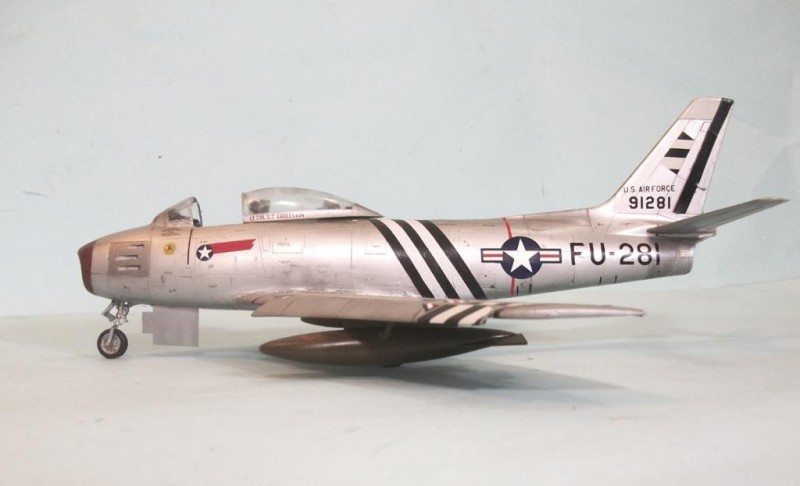
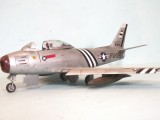
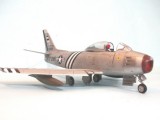
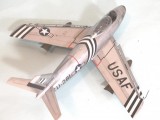
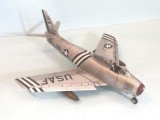

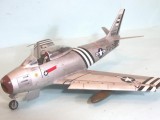
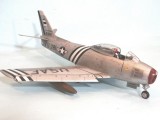
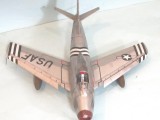

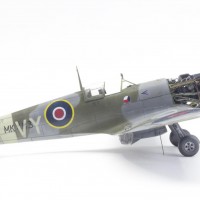
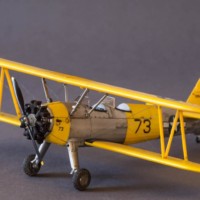
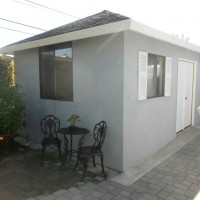
I like it Tom……you put a lot of effort into the sabre. Interesting text as usual.
Great looking Sabre Tom. I've got an Kiwi set in route and a Scobie wing, and decals on hand, so I'm only 3-5 years away from my own A model...lol
You're a cruel man, Tom, posting shots of a F-86 on a site frequented by an old Sabre jockey 😉 Ah, the nostalgia.
But forgive me if I make this Crocodile Dundee-like observation: "THAT'S not a Sabre. THIS is a Sabre." http://www.hyperscale.com/2009/features/avonsabre48kjb_1.htm
Seriously, a fine representation of a great aircraft.
I don't know if you know this, but the legendary Captain Eric Brown (Royal Navy), who during his career flew more types that just about anybody who ever lived, had this to say about the F-86:
My favourite piston engine aircraft is the de Havilland Hornet ... On the jet side I was a great admirer of the F-86 Sabre, but in particular, the Model E (F-86E) which had the flying tail, and this gave me what I call the 'perfect harmony of control'. If a pilot has this perfect harmony of control you feel you're part of the aeroplane and you're bonded with it really. You've got into it and the aeroplane welcomes you and says 'thank God you've come, you're part of me anyway' and to fly like that is a sheer delight."
And, with two 30mm Aden cannons replacing the six 50-cals and a Rolls Royce Avon providing the thrust, it really was an absolute delight in its day.
Background well stated & a model well built as usual.
Thanks.
Hello Tom...Nicely done Sabre and interesting F-86 write-up. Thanks for sharing that.
Tom,
Very nice.